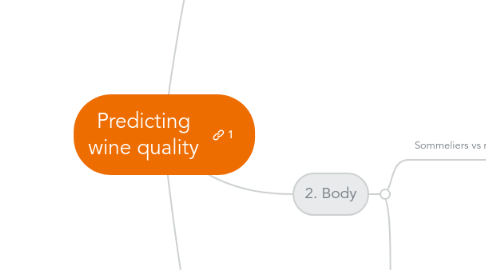
1. 1. Introduction
1.1. Credentials: Master Data Analytics in Carnegie Mellon. Top-ranked in quantitative analysis in the US. 7 years of experience with data.
1.2. Hook: Meme about good wine
1.3. Connect hook with objective: How do we know when we have a good wine? Qualities assessed by an expensive sommelier or cheap model
1.4. Objective: Adobe Guadalupe should reduce their costs of quality control by using the predictive model I will show instead of using sommeliers expensive services
1.5. Agenda
1.5.1. I. Sommeliers vs Model
1.5.1.1. a) Training of Sommeliers
1.5.1.2. b) Disadvantages of Sommeliers vs model
1.5.2. II. A model for Adobe Guadalupe
2. 2. Body
2.1. Sommeliers vs model
2.1.1. Training of a reliable sommelier is expensive
2.1.2. Disadvantages of Sommeliers. Highly trained are rare and extremely expensive. Less trained are not reliable. They have different opinions (connect with the different opinions in their wines).
2.1.3. Model: Data of highly trained sommeliers Results are reproducible and reliable. Many properties of wine are measurable and data is easy and cheap to collect (pH).
2.1.4. Input variables (based on physicochemical tests): 1. Fixed acidity 2. Volatile acidity 3. Citric acid 4. Residual sugar 5. Chlorides 6. Free sulfur dioxide 7. Total sulfur dioxide 8. Density 9. pH 10. Sulphates 11. Alcohol
2.2. The model. Results: 100% will say the same. 80% of times will say a wine is good when it is true. Can fit the model to be more sensitive to false positives to calibrate according to quality control budget. Can include your own opinion on data and features about smell.
3. 3. Closing
3.1. Summary
3.1.1. Training makes sommeliers expensive. Using a model is cheaper.
3.1.2. A model is more reliable to evaluate the wine quality in production facilities.
3.1.3. A model can be calibrated depending on the budget for quality control

